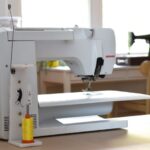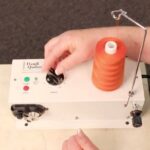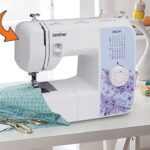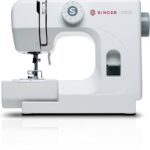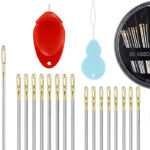Sewing enthusiasts often encounter issues like tangled threads, unstable spools, and uneven stitches. These problems can be frustrating and negatively impact the sewing experience.
That’s where spool caps come into the picture. They are small but mighty devices that make a significant difference in achieving optimal sewing results. In this post, you will learn how to use a spool cap.
What is a spool cap and how to use a spool cap? A spool cap is a small accessory used in sewing machines to hold the thread spool in place. It is typically made of plastic or metal and sits on top of the spool pin.
It secures the thread spool and prevents it from wobbling or unwinding excessively during sewing. It comes in different diameters depending on your sewing machine model.
You must also read about the sewing machine extension table: The Ultimate Guide to Sewing Machine Extension Tables
Before you know how to use a spool cap it is important to know the importance of spool cap. Spool caps serve multiple purposes and offer several benefits for you. They are designed to provide stability, prevent tangling, control thread tension, and reduce thread breakage.
- Provide stability: Spool caps prevent the thread spool from vibrating or shaking during sewing, ensuring a consistent thread feed.
- Prevent tangling: By keeping the thread spool in place, spool caps minimize the chances of the thread tangling or getting caught while stitching.
- Control thread tension: The proper use of spool caps helps in maintaining consistent thread tension, resulting in even and balanced stitches.
- Reduce thread breakage: A well-attached spool cap reduces the strain on the thread, minimizing the chances of thread breakage while sewing at high speeds or with heavy fabrics.
Spool caps come in various types, each designed to cater to different sewing needs and machine models.
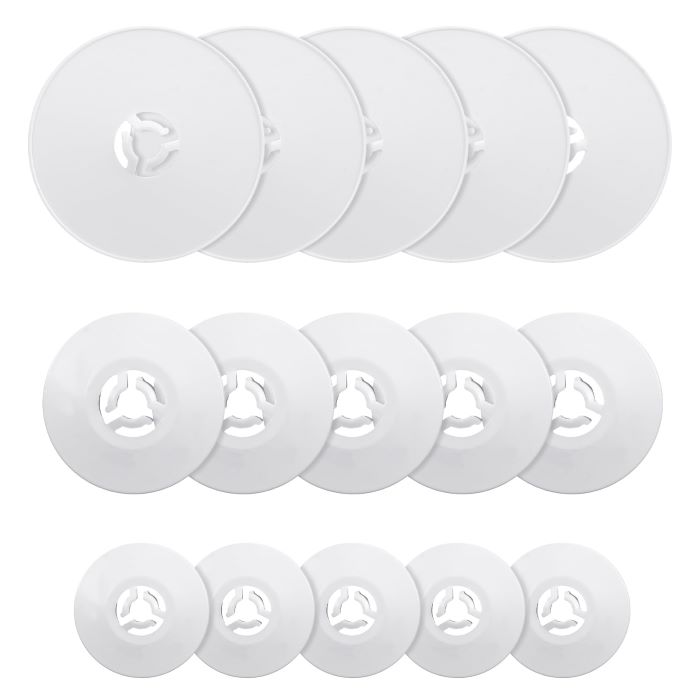
Plastic spool caps are commonly used and compatible with most sewing machines. They are lightweight, durable, and easy to replace if needed.
Plastic spool caps are suitable for regular sewing threads and are available in different sizes to accommodate various spool diameters.
Metal spool caps offer added durability and stability, making them ideal for heavy-duty sewing projects or when using thicker threads.
They provide a secure grip on the thread spool and can withstand high-speed sewing without slipping or wobbling.
Metal spool caps are often found in industrial sewing machines but can also be used with domestic models.
Thread stand spool caps are designed specifically for thread stands or vertical spool holders. They allow the thread to unwind smoothly from the stand without creating tension or tangling issues.
Thread stand spool caps are beneficial when using large or specialty threads that may not fit on the regular spool pin of the sewing machine.
You must read about how to replace the spool pin on the Brother sewing machine. How to Replace Spool Pin on Brother Sewing Machine: Complete guide
Choosing the right spool cap is essential for optimal sewing performance. Consider the following factors when selecting a spool cap.
Different sewing machine brands and models may have varying spool pin designs and sizes. It’s crucial to ensure compatibility by choosing a spool cap recommended for your specific sewing machine.
Spool caps come in different sizes to accommodate various thread spool diameters. It’s important to choose a spool cap that matches the size of the thread spool you will be using. Using an incorrect-sized spool cap can result in unstable thread feeding and tension issues.
Certain threads, such as metallic or specialty threads, may require specific spool caps for optimal performance.
Check the manufacturer’s recommendations or consult your sewing machine’s manual to ensure the spool cap is suitable for the type of thread you intend to use.
Must know about the spool pin. What is a spool pin on sewing machine? What is a Spool Pin on a Sewing Machine: A Beginner’s Guide
Now that we understand the importance of spool caps and how to choose the right one, let’s go through a step-by-step guide on how to use a spool cap effectively.
Before you begin, gather the necessary tools: your sewing machine, the thread spool, the spool cap, and a pair of small pliers (if required).
Locate the spool pin on your sewing machine. It is usually found on the top or side of the machine. It is long enough to accommodate the spool cap.
Choose a spool cap that matches the size of your thread spool. Ensure it is compatible with your sewing machine brand and model.
If your thread spool has a built-in thread holder, remove it before attaching the spool cap. Check for any tangles or knots in the thread and untangle it if necessary.
Place the spool cap on the spool pin, aligning it with the thread spool. Gently press it down to secure it in place. If your spool cap has a screw or a locking mechanism, use small pliers to tighten it if required.
Hold the thread spool with one hand while ensuring the thread unwinds freely from the spool. The spool cap should provide stability and prevent excessive unwinding or tangling.
To make the most out of your spool cap and enhance your sewing experience, consider the following tips and best practices. If you know the importance of a spool cap and how to use a spool cap then you must also follow these following tips.
- Keep your Spool Cap Clean: You must regularly clean the spool cap to remove any lint, dust, or thread residue. This will ensure smooth thread feeding and prevents any buildup that may affect the stability of the spool.
- Avoid Overloading the Thread Spool: Be mindful of the thread spool’s capacity and avoid overloading it. Excessive thread on the spool can lead to tension issues, tangling, or even damage to the spool cap or sewing machine.
- Use a Thread Net if Necessary: For threads that have a tendency to slip or unwind excessively, consider using a thread net. Thread nets can be placed over the spool to provide additional control and prevent tangling.
- Replace Damaged or Lost Spool Caps: If your spool cap becomes damaged, cracked, or lost, it’s important to replace it promptly. Using a damaged or incorrect-sized spool cap can compromise the stability and performance of your sewing machine.
Despite using a spool cap correctly, you may encounter certain issues. Here are some common problems and their possible solutions.
- Thread Tangling or Snagging: If the thread continues to tangle or snag, check that the spool cap is properly attached and the thread is unwinding smoothly. Re-thread the machine if necessary, ensuring proper tension and thread path.
- Spool Cap Slipping Off: If the spool cap keeps slipping off the spool pin during sewing, ensure that it is securely tightened, or consider using a spool cap with a locking mechanism. If the issue persists, consult your sewing machine’s manual or seek professional assistance.
- Incompatibility with Thread Types: If you experience difficulties when sewing with certain thread types, such as metallic or specialty threads. Verify that the spool cap is compatible with those specific threads. Consider using spool caps specifically designed for those thread types.
How to use a spool cap on a sewing machine correctly? Using a spool cap correctly is essential for achieving smooth, tangle-free sewing results. By understanding the importance of spool caps, choosing the right one, and following the step-by-step guide provided, you can enhance your sewing experience and improve the overall quality of your stitches.
Remember to consider the tips and best practices mentioned, troubleshoot any common issues, and keep your spool cap clean and in good condition. Regular maintenance and proper care will ensure that your spool cap continues to serve its purpose effectively.
In conclusion, a spool cap is a valuable accessory for any sewing enthusiast. It provides stability, prevents thread tangles, controls tension, and improves overall sewing performance. By selecting the right spool cap, following the step-by-step guide, and implementing the tips and best practices, you can optimize your sewing experience and achieve professional-quality results.
You must read how to transfer thread from cone to spool? How to Transfer Thread from Cone to Spool: A Comprehensive Guide
It’s important to choose a spool cap that is compatible with your sewing machine brand and model. Refer to your machine’s manual or consult with a sewing machine expert to ensure the correct fit.
Check if the spool cap is securely tightened. If it continues to slip off, you may need to replace it with a spool cap that has a locking mechanism or consult with a professional for further assistance.
It is generally recommended to use a metal spool cap for metallic threads. The added weight and stability of a metal spool cap help prevent thread tangling and ensure smooth sewing.
It’s a good practice to clean your spool cap regularly, especially if you notice any lint or residue buildup. Aim to clean it after every few sewing projects or whenever you see visible dirt or debris.
You can find replacement spool caps at sewing supply stores, online marketplaces, or directly from sewing machine manufacturers. Ensure you purchase the correct size and type of spool cap for your specific sewing machine model.


